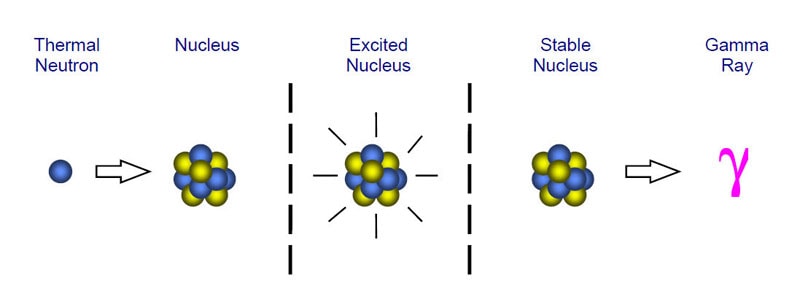At Frontier Technology Corporation (FTC), we are a leading supplier of californium-252 (Cf-252) neutron sources. Californium-252 is renowned in the nuclear, oil & petrochemical, military & defense, and research industries for its very strong neutron-emitting properties, and it is commonly used in nuclear reactors and materials scanning and analysis equipment. Neutron activation analysis (NAA) is a key analytical application of Cf-252. In this blog, we provide an overview of neutron activation analysis, outlining its process steps, variations, and advantages.
What Is Neutron Activation Analysis?
Neutron activation analysis is a non-destructive analytical technique used to determine the elemental composition of material samples. It relies on the neutrons emitted by a neutron source (e.g., Cf-252) to irradiate the sample. The flood of neutrons forces the individual elements within the sample to form into radioactive isotopes, which emit specific radioactive particles at a specific rate as they stabilize. As the radioactive emissions and decay rates for every element are well-documented, this makes it possible to detect and identify the sample’s elemental makeup.
NAA can be categorized into two classifications: instrumental neutron activation analysis (INAA) and radiochemical neutron activation analysis (RNAA). Instrumental neutron activation analysis is conducted directly on the irradiated material samples using high-resolution gamma-ray measurement equipment. Radiochemical neutron activation analysis requires the chemical separation of irradiated samples before they are analyzed to eliminate the risk of sample contamination and/or better target the desired element. Given the additional step required for RNAA, INAA is more commonly performed due to its lower time and labor costs.
There are several other methods available for determining the elemental composition of a material. However, due to its high accuracy, NAA is often used to verify or validate the results from other analysis operations.
Types of Neutron Activation Analysis
As we mentioned previously, NAA operations can be classified as instrumental neutron activation analysis or radiochemical neutron activation analysis depending on the analysis techniques and technologies employed. They can also be divided into prompt gamma neutron activation analysis (PGNAA) and delayed gamma neutron activation analysis (DGNAA) based on whether the measurement stage occurs during or after the irradiation process.
At FTC, one of our core product offerings is neutron sources for prompt gamma neutron activation analysis applications. PGNAA is an analysis technique that measures the radioactive emissions output by the sample during the irradiation stage. As it is typically applied towards elemental samples with fast decay rates (i.e., minutes or seconds), weak emissions, stable isotopes, and high neutron capture cross-sections, its operations are characterized by short irradiation times and decay periods.
In contrast to PGNAA, delayed gamma neutron activation analysis (DGNAA) measures the decay of elements after irradiation by neutrons. The delayed measurement stage improves the accuracy of measurement results for elements with longer decay periods (i.e., hours, days, weeks, or longer)
Advantages of Neutron Activation Analysis
Compared to traditional material analysis methods, neutron activation analysis offers a number of advantages, such as:
- Non-destructive. There is no risk of damage for samples subjected to NAA, which is ideal for analysis applications involving delicate or rare materials (e.g., archeological or anthropological findings)
- Broad versatility and high sensitivity. NAA can be used to identify a broad range of elements, even those in minute concentrations in a small sample.
- Fast processing time. The analysis technique can detect and measure all of the elements within a sample simultaneously.
Neutron Activation Analysis at Frontier Technology Corporation
Neutron activation analysis serves as a reliable method of accurately measuring the elemental composition of materials. As such, it is often used in research facilities (e.g., medical labs) and industrial worksites (e.g., oil and gas drilling sites) to test samples for the presence of desirable and undesirable compounds.
For more information about NAA, turn to the experts at FTC.
At Frontier Technology Corporation, we provide high-quality neutron sources suitable for use in PGNAA operations. To learn more about the neutron activation analysis process and how Cf-252 serves as an ideal neutron source, contact us today.


